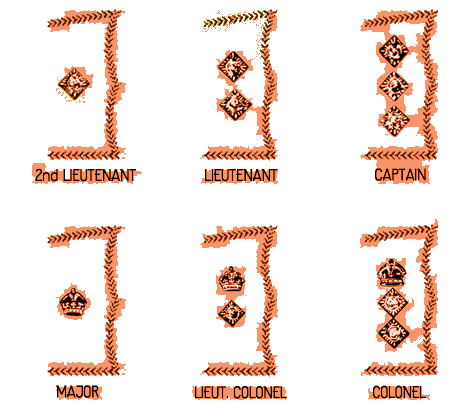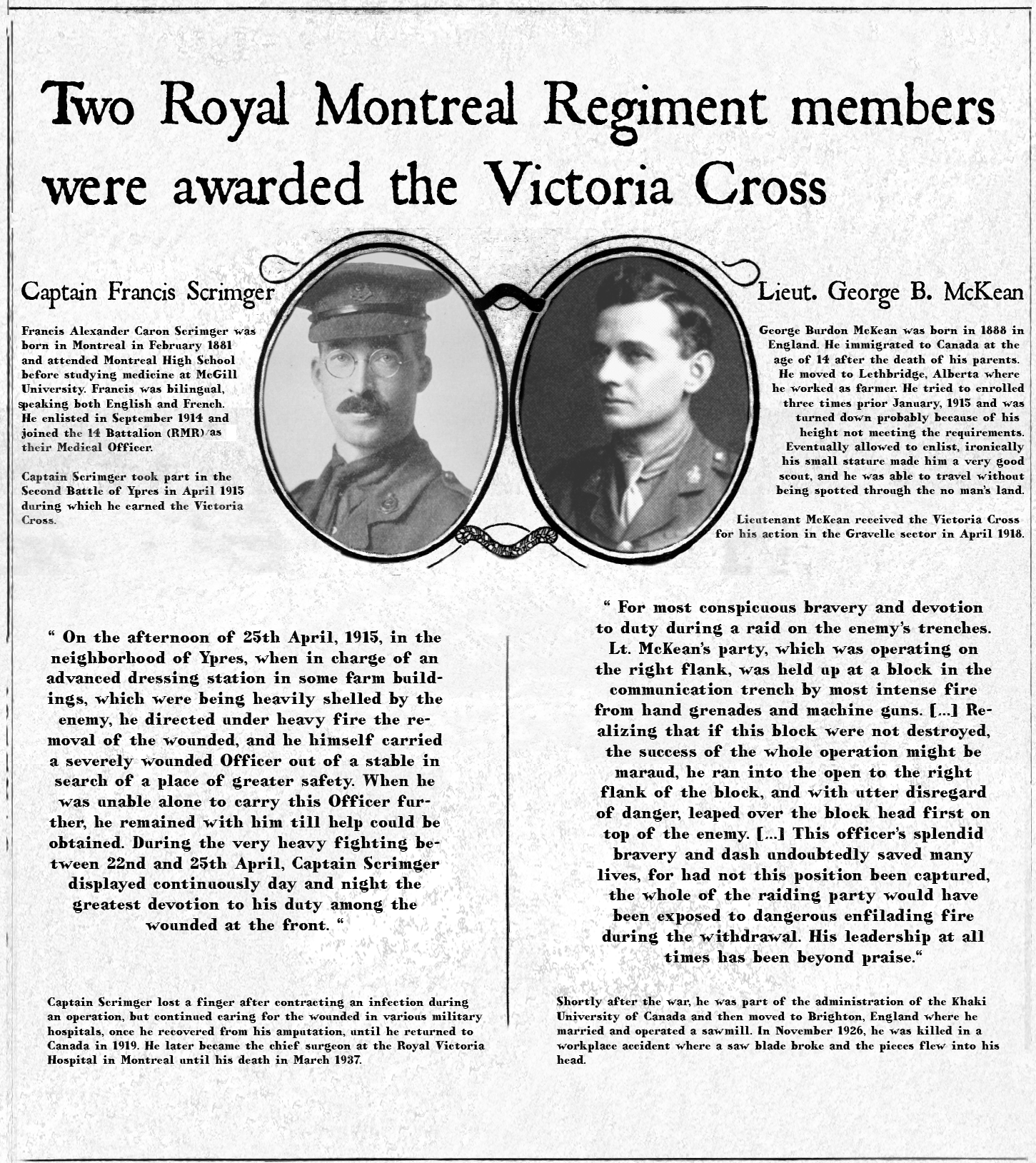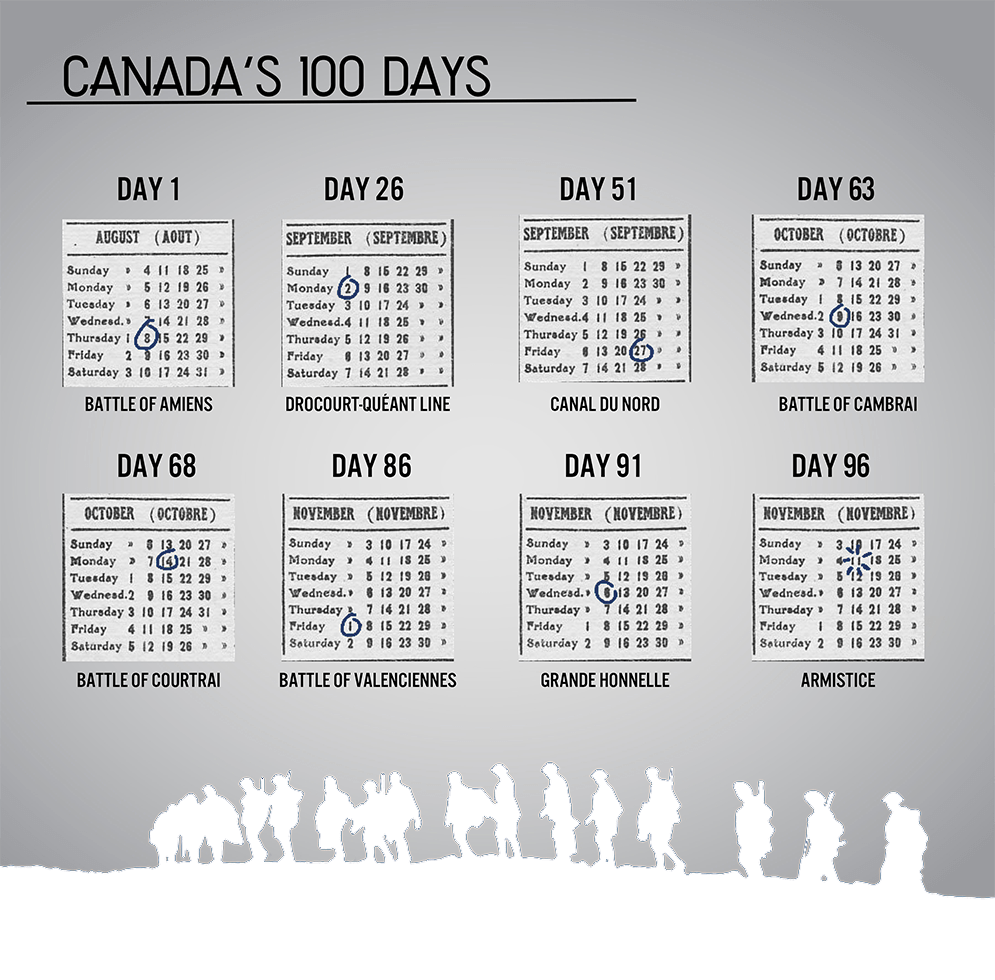Follow Canada: The Last 100 Days of the War
Canada’s role in WWI became strategic and pivotal in winning the War. Canada’s and the RMR’s role as shock troops (the name comes from the literal translation of the German word Stoßtrupp and is used to describe highly mobile troops sent as reinforcement to critical battle points to provide a quick and strong attack) in the “Last 100 Days”, the evolution of warfare and acts of valour by “ordinary” Canadians led to the Armistice on November 11, 1918, albeit at the devastating cost of thousands of lives.
What happened?
Chronology of important Canadian WWI milestones, technological advances in warfare and devastating losses.
1915
- December 1915- Medical officer John McCrae wrote the famous poem ‘In Flanders Fields’ to grieve for a friend who was killed. First published in Punch Magazine.
- April- May 1915- The Second Battle of Ypres: The first major battle for the Canadians. On this battlefield, chlorine gas was introduced by the Germans causing Allied troops to retreat. The Canadians held strong and stopped the Germans from advancing. Canadians troops gained the reputation of being tenacious.
- May 1915- The Battle of Festubert: The Germans held the advantage on the field. The Canadians had very little preparation time and were given inaccurate maps to prepare for their assault. This battle showed the importance of reconnaissance and preparation.
1916
- April 1916- The Battle of Saint-Éloi: Helmets were introduced to British and Canadian troops. This reduced the number of head wounds caused by shrapnel, reducing the number of deaths.
- June 1916- Battle of Mount Sorrel: The 3rd Division of the Canadians Corps was attacked by the Germans near the city of Ypres with heavy artillery. Canadians, coordinating artillery and infantry, counter-attacked and won the position, albeit at a heavy cost.
- February- December 1916- The Battle of Verdun began as the Germans experimented with attrition warfare. Their goal was to “bleed France white” by forcing them to repeatedly attack an area of symbolic value which would be turned into a “meat grinder”. Approximately 150,000 men were killed on each side by the time it ended on December 19th.
- July- November 1916- Battle of the Somme: Launched by the British to take pressure off the French in Verdun. Lasting some four months, the Somme was one of the bloodiest battles ever fought: 20,000 British soldiers were killed on the first day of the battle.
- Canadians were fed into the Somme campaign, taking Courcelette with the help of a new invention: Tanks. Known at the time as “land battleships”, were introduced for the first time during the Battle of the Somme. Rudimentary tanks the size of a modern school bus lumbered slowly towards the enemy lines, creating panic amongst the Germans. Mechanically unsound, most tanks broke down.
- The Somme campaign petered out with some 200,000 killed on both sides (24,029 Canadian casualties in 2-months of fighting).
- Verdun and the Somme had cost almost two million casualties.
1917
- Early 1917- Vimy Ridge: the Canadian Corps was tasked with the capture of Vimy Ridge. Previous attempts to seize the ridge by French and British troops had been unsuccessful.
- The Canadians had to apply the lessons learned from their own battle experience, and that of their Allies, to carefully plan an operation that would succeed.
- Assaulting infantry battalions had to locate the enemy. For the first time ever, not only officers, but all soldiers were given details about their objectives.
- 40,000 trench maps were printed and distributed to the attacking Canadians.
- A ‘creeping barrage’ was a method of coordinated artillery fire designed to create a ‘wall of steel’ that moved forward slowly at a predictable rate ahead of the advancing troops. Soldiers practiced their timing to coordinate perfectly with the artillery barrage. This rate of advance became known as the ‘Vimy glide’.
- Preparations for Vimy included extensive underground excavations. This included placing large amounts of explosives near or beneath the enemy’s position in “mines” at the end of underground tunnels. These were to be blown up just before the attack began. When detonated, the explosions would destroy part of the enemy’s trenches and the attacking troops would rush into the gap created.
- Air reconnaissance helped to locate vital enemy locations. German artillery emplacements and trench systems were spotted and mainly destroyed before the arrival of the infantry because of the close coordination between the pilots and the gunners. Airplanes and the concept of humans flying had only been created 14 years earlier by the Wright brothers!
- The Americans joined. In response to the German sinking of American ships, the U.S. joined the Allies. This would tip the balance in favour of the Allies when 10,000 men a day began arriving from the U.S. in early 1918.
- With casualties mounting overseas, Prime Minister Sir Robert Borden pushed for conscription to make up for the recruiting shortfalls required to fill the ranks of the Canadian Corps. Heated debate raged across Canada for a year and forcing an election, sparking riots, and finally earning Canadian women the right to vote.
- In 1917, for the first time, Canadians were led by a Canadian commander, Lieutenant-General Sir Arthur Currie. Capturing a strategic, dominating point near the city of Lens, the CEF seized considerable territory and inflicted tremendous casualties on the Germans, at a cost of 9,198 Canadian casualties.
- July 1917- The Battle of Passchendaele, also called the “Third Battle of Ypres” was launched by the British in July to secure the Belgian coastal ports and quickly became synonymous with “mud”. Water and mud made the combat very difficult and slowed movements to a crawl. The offensive had ground to a near-halt by October when the Canadians, now regarded as Shock Troops, were ordered to finish it off. They achieved success, fighting for weeks through waist-high mud to capture Passchendaele, a strategic village that dominated the Ypres salient.
- The cost was high: 15,654 Canadian casualties. Overall there were 500,000 combined German and British casualties.
- Casualties were similarly high for both sides: 275,000 for the Allied Forces and 220,000 for the Germans. The Germans had a harder time recovering as the United States had just joined the Alliance and their manpower would soon arrive.
- August 1917- Hill 70: Canadians captured Hill 70 in France under the command of Canadian General Arthur Currie, the first time a Canadian Corps was led by a Canadian. In one day 1,056 Canadians died, 2,432 were wounded and 39 were taken prisoner. At the end, 9,000 Canadians were killed or wounded, and an estimated 25,000 Germans killed or wounded. Six Victoria Crosses were awarded.
1918
- The Battle of Amiens was a highly successful surprise assault conducted by Canadians and Australians as ‘shock troops’. This battle marked the beginning of the end for the German troops.
- The Hindenburg Line was a defensive position held by the Germans. Defensive fortifications were built in the winter of 1916 with concrete, steel and barbed wire – defences running several kilometers front to back. The line was broken in September 1918.
- After the downfall of the Tsar, the Russian Bolshevik government signed a peace treaty effectively ending the war on the Eastern Front, allowing the Germans to transfer a million men to the fighting in France and Flanders.
- Attempting to win the war before the Americans arrived in strength, Germany launched a series of attacks that saw the deepest advances along the Western Front of either side since 1914. Initial panic was replaced by stiff Allied resolve and counterattacks. Germany was unable to supply their advancing troops, who began to starve in some cases. Exhausted, exposed, and unable to replace their casualties, the Germans had gambled and lost. Canadians were not involved in the fighting, holding the line elsewhere.
- The Allied forces (French, American, and British) developed the first use of combined arms (tanks, artillery, airplanes, and infantry) and recaptured most of the territory lost in the German spring offensive.
- The Canadian Corps spearheaded the next Allied attack that would eventually end the war. Attacking at Amiens on August 8th and advancing 20kms in three days, Canadian troops produced spectacular results including the breach of the infamous Drocourt-Queant Line. The commander of the German Army referred to August 8th as “the black day of the German Army.“
- General Currie devised an audacious plan to smash through the last major German prepared defensive positions at the Hindenburg Line. At Canal du Nord, the entire Canadian Corps of 100,000 men pushed through a gap barely a kilometer wide and overwhelmed the Germans.
- Armistice and the end of the First World War: 619,636 men served in the Canadian Expeditionary Force, including 424,589 who went overseas. Of those, 172,950 were wounded, 3,842 taken prisoner, and 66,665 were killed: a 57% casualty rate for overseas service.
- The Canadian war record earned Canada a separate signature on the Versailles Peace Treaty signifying that national status had been achieved. Nationhood was purchased for Canada by the sacrifice of the men of the CEF.
The war on the Western Front was fought in trenches – long, narrow, deep, and muddy ditches. The Canadian infantry were rotated in and out of the trenches as it was the most dangerous place on earth to be, and it was extraordinarily uncomfortable. The soldiers lived with vermin such as rats, lice, maggots, and flies which created serious health risks. The trenches were also constantly exposed to the weather. Here is what a day in the trenches looked like for soldiers.
Afternoon
Night
Morning
An Overview of the Canadian Uniforms
Each soldier carried a minimum of 60 pounds of equipment. Adding to that, the weight of mud collected on uniforms and equipment typically added another 60 pounds.
The Canadian Expeditionary Force soldiers wore the same uniform which was made from a thick wool and dyed in khaki. Wearing a drab color was a good way to camouflage on the battlefield.
Officers’ uniforms like this one on the left were slightly different from those worn by soldiers. Officers had a button shirt and a tie underneath a opened collar jacket. Their pants were not a straight cut but larger around the thighs and tighter around the calves. Officers were also allowed to carry certain objects with them such as a whistle, a camera and a handgun.
What’s an Officer ?
An officer has a wide range of responsibilities such as coming up with plans and being trusted with the execution of operations and daily activities. Officers are in command so they issue orders and lead soldiers to achieving the plans.



The Last Hundred Days? Well, 96 days.
Between August 8th, 1918 and November 11th, 1918, the Allied forces led a series of successful attacks on the Western Front. The Canadian Expeditionary Force contributed greatly to this last push and the event was nicknamed “The Hundred Days”.
German troops were pushed back from Amiens, France to Mons, Belgium in under 100 days by a fast-moving infantry force supported by tanks, aeroplanes and a well-coordinated artillery. The retreating German troops were unable to retaliate and their morale progressively worsened.
On November 11th, at 11:00 am the Armistice was signed and the fighting stopped. It took a further six months to negotiate the Treaty of Versailles, which was signed on June 28th, 1919.
Overview of WWI Medals
Virtually every country has a formal system to bestow honours on their citizens, and most also have specific honours reserved exclusively for members of their armed forces. Canada’s honour system is called the Order of Canada in which specific insignia are given to reward service or a valorous act.

Additional resources
To know more about soliders
Government of Canada – Service Files for WWI (personnel records)
https://www.bac-lac.gc.ca/eng/discover/military-heritage/first-world-war/personnel-records/Pages/search.aspx
Veterans Affairs Canada – Book of Remembrance
http://www.veterans.gc.ca/eng/remembrance/memorials/books/search
Circumstances of death registers – WWI – Library and Archives Canada
http://www.bac-lac.gc.ca/eng/discover/mass-digitized-archives/circumstances-death-registers/pages/circumstances-death-registers.aspx
Commonwealth War Graves Commission
https://www.cwgc.org/
Library and Archives Canada – Military Medals, Awards and Honours
http://www.bac-lac.gc.ca/eng/discover/military-heritage/military-medals-1812-1969/pages/military-medals-honours-awards.aspx
Multimedia material
The National Film Board of Canada’s (NFB) docu-drama about the life and experiences of famed Canadian fighter pilot Billy Bishop during WWI
https://www.nfb.ca/film/the-kid-who-couldnt-miss/
Encyclopedia Britannica video clip on the end of the War (3:36mins)
https://www.britannica.com/event/World-War-I/The-end-of-the-German-war
Claude Cloutier’s NFB short animation, The Trenches, 6:55 mins. No dialogue, only sound (powerfulshelling, fear)
https://www.thecanadianencyclopedia.ca/en/article/first-world-war-wwi/
NFB short doc (9 mins) Front Lines-The Trenches
https://www.nfb.ca/film/front-lines-the-trenches/
Documentation
Canadian Encyclopedia – Timeline, chronology of events
http://www.thecanadianencyclopedia.ca/en/timelines/first-world-war-timeline/
